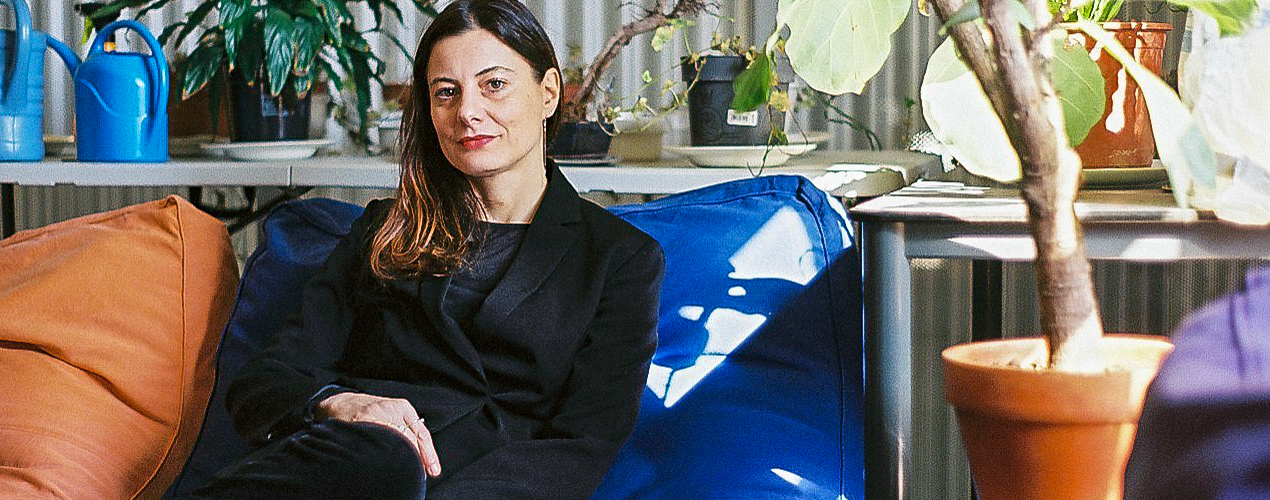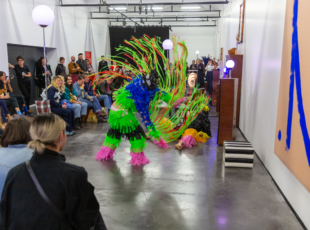Giulia Vismara, electroacoustics as a sound space

Article author :
An uncategorisable musical genre, electroacoustics first emerged in the 1950s. Any attempts to establish a definition, now and again too generic, sometimes too clear-cut, have been the source of heated debate amongst academics and practitioners. And yet, without it, our films and our theatre plays would not have the same pizzazz. Such is the argument the composer and researcher Giulia Vismara endeavours to outline in her artwork, which explores sound as a space.
(To experience an immersive reading, plug in your headphones and prick up your ears to Speaking Spaces 2: Surfaces from Graz, by Natasha Barrett, a British composer of electroacoustic music)
When we think about classical music, Mozart, Chopin and Bach are frequently cited. For the pop genre, we immediately hear tunes by the Beatles. But in electroacoustics? A conundrum. In the opinion of Bernard Fort, a composer and a composition teacher at the École Nationale de Musique Villeurbanne, who has a gift for popularising the genre, electroacoustics – also known as concrete or experimental music – is ‘a music which begins with a microphone in the hand and is completed by listening to a loudspeaker’. Succinctly, the recording of sounds, assemblage and composition on a computer to come up with a product we call ‘electroacoustic’, since it is not instrumental music.
Distorted voices, computer-generated noises, the sounds of household objects, etc. Many electroacoustic compositions use sounds which are unattainable for a traditional orchestra. And although the average people on the street are not fighting each other tooth and nail over electroacoustic albums, we nonetheless could no longer live without this genre. Live performances, the seventh art, animated films; a whole raft of artistic expressions requires the use of electroacoustic music. ‘If it remains niche and little known, it is because, amongst other reasons, electroacoustic is very young, historically speaking!’ claims Giulia Vismara. In fact, this music genre is only a good sixty years old. In other words, almost nothing in comparison with opera or even jazz. ‘It is also intimately linked to the development of recent technologies: the microphone, the loudspeaker and, in between the two, the computer,’ she continues. ‘Tech is the real source of electroacoustics writing.’
Behind the origins of electroacoustics, a Frenchman
In the aftermath years of the Second World War, the French acoustic engineer and radio broadcaster Pierre Schaeffer accidentally ‘invented’ this new compositional technique. The idea came to him whilst he was doggedly listening to the same fragment of a scratched 78 vinyl record over and over again. He realised that listening to this fragment of the real on a loop, removed from its context, produced an effect quite unlike any other. More interested in the process than in the creation of a new musical genre, Schaeffer began to look for other raw sounds and ended up composing his first work, Études de bruits, in 1948. There followed the sequel, Bidule en ut, and, in 1950, in collaboration with Pierre Henry (another of the genre’s major authors), Symphonie pour un homme seul. This symphony would later be adapted into a ballet by Maurice Béjart and could even be heard in concert, played by an orchestra of loudspeakers called an ‘acousmonium’. During this period, the term ‘concrete music’ was used to describe it, but the latter genre is inextricably bound up with technological progress and evolves in parallel with electronic music. In the mid-1950s, the tandem of genres coalesced and people who were interested in it would more broadly use the term ‘electroacoustics’.
Architect of sound
Born in Venice and dividing her time between Belgium and The Peninsula, Giulia Vismara holds a doctorate in Sound Design from the IUAV, University of Venice. Her works span across electroacoustic music, installations, composing music for the theatre, performance and video art. ‘The cornerstone of my work has always been the exploration of the organic nature of sound as a space. I create textures by combining concrete and computer-generated elements. But electroacoustics remains difficult to define in my opinion because the generic term tries to encompass various types of electronic music. You could say that it is a form of musical expression which requires electronic mediation.’
Electroacoustics on the big screen
The use of electroacoustic music has extended into mainstream cinema, with a certain amount used in television, almost to the point where it has become unrecognisable, several observers have noted. But some references to the seventh art are more exemplative than others. Such as the composition work of the sound designer Eugene Gearty in Eternal Sunshine of the Spotless Mind, the science-fiction drama directed by Michel Gondry, featuring the highly amusing Jim Carrey and Kate Winslet, or Christopher Nolan’s Interstellar.
One type of common thread amongst electroacoustic artists: they are often active in music composition and in academic research involving sound, being a lot more interested in the substance of sound than in the melody or the beat, unlike composers working in other genres, who have been exploring those particular aspects brilliantly for centuries. But the Italian hasn’t always made sounds pour forth by lurking behind her computer screen. Having trained in classical music, Giulia practiced the violin at the Conservatory, to begin with, before going on to study musicology. The artist confesses to having fallen into electroacoustics as a teenager, having artlessly played around with a recording device. ‘As an adult, I then had the opportunity to work in an arts centre which was in particular responsible for running an electroacoustics music festival. I also looked after their sound archives. It was there that I discovered the essence of this genre, on the boundary between art and music.’
Electroacoustics, and sound more generally, is a tool which enables me to create spaces without borders.
Inspired by the artists with whom she has in particular studied – Trevor Wishart, Alain Savouret and Natasha Barrett, whose work you are at the moment perhaps listening to, if you have followed our recommendations at the beginning of this article – Giulia Vismara is today more extensively exploring the spatialization of sound thanks to 3D technologies. In her art research projects, she is for example investigating the field of auralization. A technological procedure aiming to recreate a specific acoustic environment on the basis of measured or simulated data. ‘You could thus consider recreating the atmosphere of a cathedral in a low-ceilinged room. Electroacoustics, and sound more generally, is a tool which enables me to create spaces without borders. A completely different concept to the standard consideration of space as predetermined or to be conquered.’
Whilst she would like to get back to electroacoustic composition for the cinema, the sound artist also highlights an approach which aims to be accessible, in particular when she leads introductory workshops on electroacoustics, or through participatory projects such as Tracks. ‘With Franziska Windisch, an artist work colleague, we have produced a soundwalk [Editor’s note: the much-talked of phenomenon we discussed in our sound ecology case file] in the Curreghem neighbourhood, in Anderlecht.’ Available via the Tracks app, each walker can plug in their earphones and listen attentively to electroacoustic pieces designed in part using recordings of the sounds native to the area. A means of (re)discovering your own sound environment in the audio guide manner, where ‘point of view’ becomes ‘point of listening’.
A story, projects or an idea to share?
Suggest your content on kingkong.





